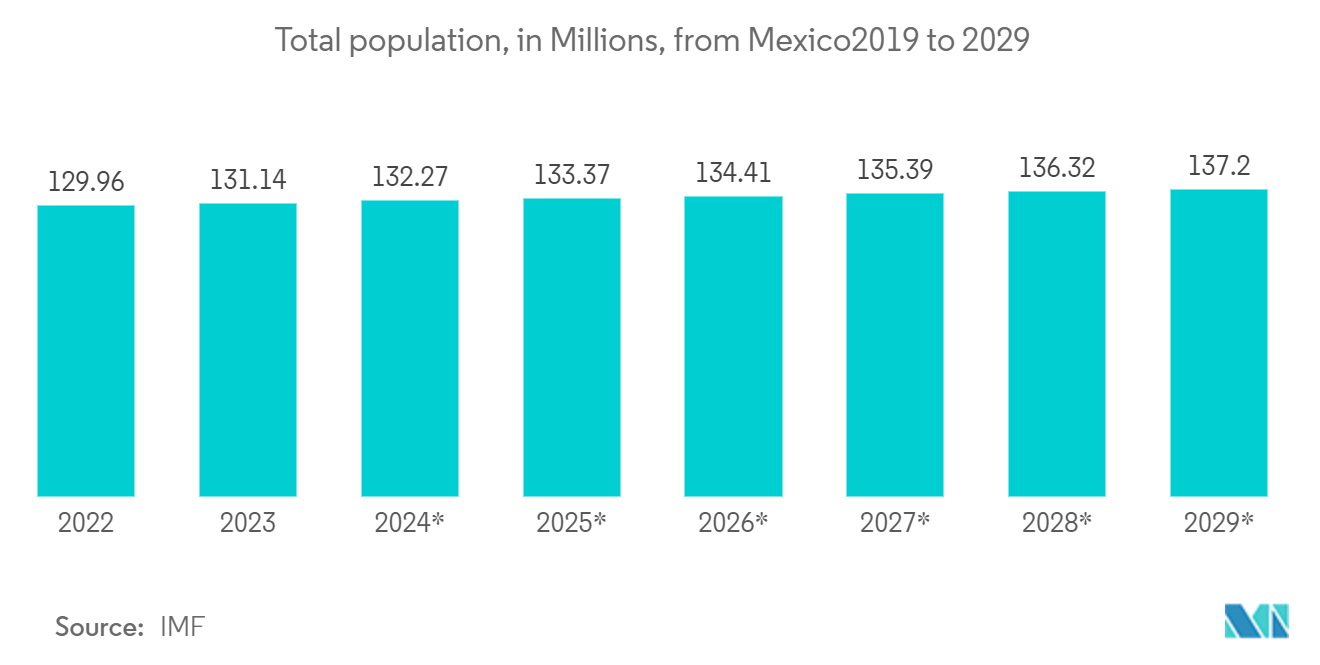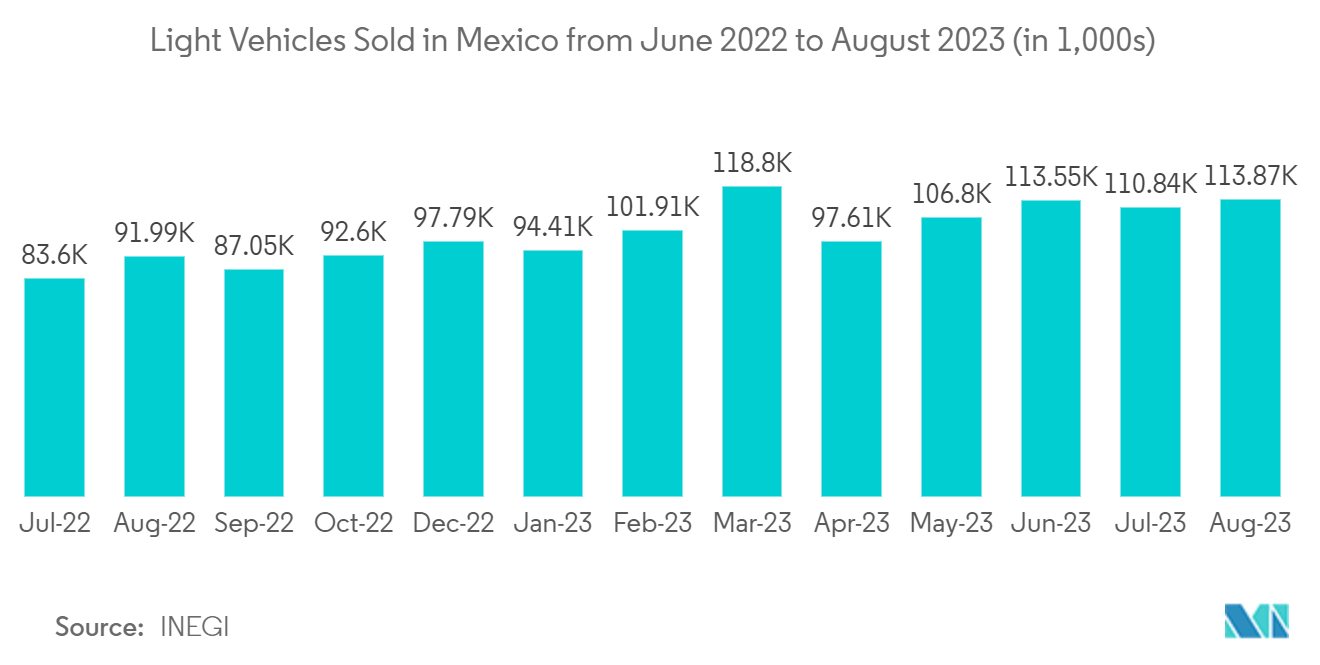Market Trends of Mexico LED Lighting Industry
Increasing Demand for Outdoor Lighting Due to Smart Development Initiatives to Drive the Market Growth
- In Mexico, though the LED penetration is low for the residential end user, the government mainly focuses on outdoor lighting to decrease electricity consumption and greenhouse gas emissions. According to the study by INEGI (The National Institute of Statistics and Geography), the average penetration of LED in residential rooms is just 12 percent in the country. Also, increasing government investments and initiatives in the region to develop public infrastructure facilities are boosting the street lighting market growth, fuelling the demand for LED lights.
- The city of Santa Fe's portion of its streetlight conversion project ended in March 2022 when the last 3,500 city-owned fixtures were restored to energy-efficient bulbs. The USD 2.9 million projects, part of the city's push to go carbon-neutral by 2040, are anticipated to save the city USD 550,000 in electricity bills per year and lower energy use by 50 percent to 60 percent, as the city's streetlights were earlier high-pressure sodium lights with a shorter life span and a higher failure rate than LED lights.
- The Servicio Express Aeropuerto Carret on Monterrey-Laredo Highway required an energy-efficient lighting solution for the service station's parking lot and canopy surrounding the pumping stations. The authority has cited replacing the old 23 inefficient metal halide flood and canopy fixtures with LED preserved energy of 268,000 kWh and USD 32,160 in energy and maintenance. Moreover, many major cities in Latin America, including those in Mexico, have started digital transformation processes, setting them on a path to evolving smart cities despite pandemic setbacks. For instance, Mexico City, Mexico's capital, persists in progressing in its smart city project. Such developments also open new opportunities for the market.
- Moreover, According to the International Energy Agency (IEA), Mexico's population is projected to reach nearly 150 million by 2050, a significant increase from the current 127 million. This, coupled with advancements in productivity, will drive economic growth. Consequently, energy consumption will substantially rise, necessitating the adoption of energy-efficient lighting systems.
- Mexico's electricity sector has experienced rapid growth, with an average annual demand increase of 1.6 percent since 2000. As a result, the government's increasing investments and initiatives to develop public infrastructure facilities in the region are stimulating the growth of the street lighting market, consequently fueling the demand for LED lights.
- The rising plans and investments in smart city initiatives are expected to drive the demand for energy-efficient outdoor lighting further. Latin America is poised to emerge as one of the most densely urbanized regions globally. The United Nations predicts that by 2050, approximately 70 percent of the global population will reside in urban areas. In Latin America, this figure is projected to reach a staggering 90 percent. Furthermore, Mexico City has initiated implementing a comprehensive smart city strategy known as the "Connectivity Master Plan for Mexico City." This plan integrates cutting-edge technologies and innovative concepts from smart city initiatives worldwide with the city's existing infrastructure.

Industrial Use of LED Lighting in Mexico is Expected to Grow Significantly
- The industrial utilization of LED lighting in Mexico is anticipated to experience substantial growth. Renowned for its superior quality, Mexico stands as one of the leading exporters of medical devices to the United States and certain regions of Latin America, owing to its abundance of medical device manufacturing companies. The increasing production capacities and investments in the sector are projected to fuel the widespread adoption of LED lighting.
- LEDs are an ideal source of surgical lighting due to their extended lifespan and minimal heat emission. The region's burgeoning medical devices market presents significant LED lighting opportunities. Among the 2,000+ companies manufacturing medical devices in Mexico, including Johnson & Johnson, Medtronic, GE HealthCare, Philips, and Kimberly-Clark, Gilero recently invested USD 2.5 million to establish a Tijuana-based plant focused on design, development, and contract manufacturing of medical devices, inaugurated in December 2022. Such developments in the industry are expected to increase the need for LED Lights in medical devices.
- Mexico has a severe freshwater shortage, and water reuse is broadly practiced across the region. UV-based consumer products, including sterilizers and disinfectants, are expected to gain significance during the forecast period, given that 80 percent of the population is urban, as per the World Bank. Furthermore, the World Health Organization has reported that UV-based disinfectants are increasingly prevalent in the country, as healthcare-associated infections (HAIs) remain the leading cause of mortality.
- According to UN Comtrade, in 2021, Mexico was the third biggest exporter of lighting fixtures and fittings to the rest of the world with approximately worth about USD 2 billion, following just China and Germany as the biggest and the second biggest exporters of lighting fixtures and fittings, with an export value of about USD 50 billion and USD 3.45 billion respectively. LED solution vendors are increasingly establishing a stronger foothold in Mexico to cater to the continuous local demand. Aquionics, a renowned manufacturer of UV-LED-based disinfectant products and a subsidiary of the esteemed Halma Group, has bolstered its workforce in Mexico in anticipation of the growing need for industrial LED lighting.
- As industrial output in the region continues to experience significant growth, there is a corresponding increase in the reliance on electricity. Additionally, manufacturers often require additional support to cover substantial operational costs. The escalating energy expenses are a crucial factor driving manufacturers to embrace energy-efficient lighting solutions, such as LED. Numerous warehouses currently utilize linear fluorescent lamps or metal halide lamps for illumination. Although these options are an improvement over incandescent bulbs, they still pose challenges such as disposal hazards, shorter lifespan, and less efficient lighting when compared directly to LEDs. Consequently, these warehouses are now transitioning to LED lighting.
- The market is anticipated to experience growth due to the rising adoption of LED lights in the Automotive industry. LED lights are extensively utilized in automotive lighting due to their superior efficiency, durability, and energy-saving capabilities compared to conventional incandescent bulbs. LED lights are increasingly replacing xenon and halogen lights in various automotive applications, including brake, reading, side, and marker lamps. LED lighting has gained significant popularity in the automotive industry and is projected to remain the fastest-growing technology due to increasing sales.
- In February 2023, According to the National Institute of Statistics and Geography (INEGI), the automotive industry in Mexico experienced a significant surge in sales during July. A total of 110,843 light vehicles were sold, indicating a remarkable growth of 32.6 percent compared to the 83,598 units sold in 2022. These figures surpass the pre-pandemic records. Notably, the top three companies in terms of new car sales in the Mexican market remained unchanged, with Nissan, General Motors, and Toyota leading the pack in that respective order. Collectively, these three companies accounted for 40 percent of the total units sold in the country during July. Significant developments in the automotive industry will create the demand for LED lighting fixtures in the region's automotive sector.


